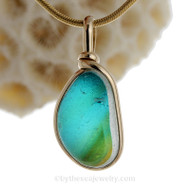Goldfilled VS. Gold Plated
17th Oct 2018
Here's the rundown on the differences between gold-filled vs. gold-plated.
So, you’re curious about the differences between gold-filled and gold-plated jewelry. Maybe you’ve already done some research but have come across confusing, conflicting, or down right false facts on the subject. Never fear, below you can find the research we’ve done into the subject, along with an infographic that you can print so you’ll always have it on hand.
Now let’s get started.
Is Gold-Filled the same as Gold-Plated?
No. Not only are their manufacturing processes different, but the amount of gold alloy used on gold-filled pieces is different than gold-plated.
The layer of gold alloy on gold-plated jewelry is so minuscule it is barely noticeable in the above image. Gold-filled jewelry has 100x more gold alloy than gold plated and because that layer is so much thicker, it means gold-filled jewelry lasts longer and stands up to wear and tear better than gold plated. All it would take is one small scratch on a gold-plated piece to expose the jeweler’s brass underneath.
Why is there such a difference in the amount of gold alloy? The answer lies in the manufacturing process:
To make gold-filled pieces, the core metal is sandwiched between two layers of gold alloy which is then heated and passed through a roller several times – a process that both bonds the metals together and thins the sheet out.
To make gold-plated pieces, an electric current is used to negatively charge the base metal and positively charge a solution containing gold ions. The positive gold ions are attracted to the negative charge of the core metal, slowly forming a layer of gold on top of the core.
Thicker amounts of gold alloy can be added during both processes but typically the amounts shown before are the standard.
How do they compare durability wise?
As said before in the first section, gold-filled pieces are generally more durable than gold-plated due to the thicker layer of gold alloy. The longevity of either type is dependent on wear, environment, and quality of the piece.
As long as the piece is well cared for, gold-filled jewelry can last a lifetime.
Gold plated jewelry is not very durable and can’t stand up to much heat, water, or wear.
What about Tarnishing?
The thickness of the gold alloy layer also affects the piece’s chance of tarnishing.
Due to the thin layer of gold which can easily wear off, gold plated pieces can tarnish once the core metal is exposed.
To clean gold-filled jewelry without scratching it (which would lead to tarnishing) use an untreated cloth or mild soapy water. Do not scrub the piece. As for gold-plated, clean only if you absolutely must. We suggest using a cotton ball and as with gold-filled do not scrub.
Best Uses
After all this you are probably wondering what’s even the point of gold-plated jewelry. We’ll give you a couple of ideas on when to use gold-filled or gold-plated jewelry.
Gold-filled jewelry is best used where longevity and durability are a must. Gifts for anniversaries, birthdays, and other such events are much more meaningful when the piece is meant to last decades. Another such occasion is when a piece is worn on a daily basis – a gold-plated piece would last mere months if worn daily.
Gold-plated jewelry is great for those ‘of the moment’ trends. This way you can be a part of the trend without having to worry about whether your investment into a more expensive piece was worth it. Jewelry for costumes and cosplay is another great use for gold-plated jewelry. These pieces tend to be worn once or twice so the look is more important than the durability.
Post Compliments of
Share:

